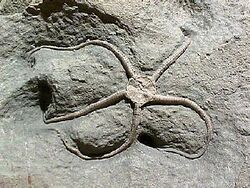Biology:Paleocoma
| Palaeocoma | |
|---|---|

| |
| Palaeocoma milleri (Philips, 1829), from the Lower Jurassic (Pliensbachian) Starfish Bed, Eype, Bridport, Dorset, England. Complete specimen from the margaritatus Zone, which measures 9.5 cm (3.7") across, on matrix. | |
| Scientific classification | |
| Kingdom: | |
| Phylum: | |
| Subphylum: | |
| Class: | |
| Order: | Ophiurida
|
| Suborder: | Ophiurina
|
| Family: | Ophiurina incertae sedis[1]
|
| Genus: | Palaeocoma d'Orbigny, 1850[2]
|
Palaeocoma is an extinct genus of brittle stars that lived during the Middle Triassic to Early Jurassic Periods. Its fossils have been found in Europe.[3]
Distribution
The genus Palaeocoma was revised by Hess (1960, 1962)[4][5] and is known from the Middle Triassic (Ladinian) to the Lower Jurassic (Toarcian) with occurrences reported from the United Kingdom (Hess, 1964; Kutscher, 1996),[6][7] France (Thuy, 2011; Thuy et al., 2011),[8][9] Luxembourg (Kutscher & Hary, 1991),[10] Germany (Kutscher, 1988),[11] Switzerland (Hess, 1960, 1962), Italy (Pinna, 1985),[12] and Serbia and Montenegro (Bachmayer & Kollmann, 1968).[13]
Type species
Palaeocoma milleri (Phillips, 1829)[14] [= P. gaveyi and P. egertoni according to Jaselli (2015, p. 192)], an Early Jurassic (Sinemurian and Pliensbachian) species recorded from France, Germany, Luxembourg, the United Kingdom and Lombardy in Italy.[15]
Synonymised names
- Ophioderma carinata Wright, 1866[16]
- Ophioderma egertoni (Broderip, 1840)[17]
- Ophioderma gaveyi Wright, 1854[18]
- Ophioderma milleri (Phillips, 1829)
- Ophiura egertoni Broderip, 1840
- Ophiura milleri Phillips, 1829
- Ophiurella milleri (Phillips, 1829)
- Palaeocoma egertoni (Broderip, 1840)
- Palaeocoma gaveyi (Wright, 1854)
Other species
- Palaeocoma escheri Herr, 1865[19] [= Ophiura ventrocarinata Quenstedt 1876][20] was redescribed by Hess (1960) and is from the Lower Lias Staffelegg Formation,[21] of Schambelen near Mülligen in the Canton of Aargau of northern Switzerland . It occurs in the Hettangian, the earliest age and lowest stage of the Jurassic period and, specifically, the Psiloceras planorbis Ammonite Zone.
- Palaeocoma raiblana (Toula, 1887).[22] This species is only found in the Triassic Wengener Schichten Formation (Ladinian) of Budva in Serbia and Montenegro).
Gallery
References
- ↑ Stöhr, S., O’Hara, T., Thuy, B. (Eds), 2020. World Ophiuroidea Database. Ophioderma Müller & Troschel, 1840. Accessed through: World Register of Marine Species on 2020-11-01.
- ↑ Orbigny A. D. d'. (1850-1852). Prodrome de paléontologie stratigraphique universelle des animaux mollusques et rayonnés faisant suite au cours élémentaire de paléontologie et de géologie stratigraphiques. Paris: Masson. vol. 1 [January 1850 ("1849")]: lx + 394 pp.; vol. 2 [November 1850]: 427 pp.; vol. 3 [1852]: 389 pp.
- ↑ Cyril Walker, David Ward Fossils : Smithsonian Handbook, ISBN:0-7894-8984-8 (2002, paperback, revisited), ISBN:1-56458-074-1 (1992, 1st edition). Page 189.
- ↑ Hess H. (1960). Ophioderma escheri Heer aus dem unteren Lias der Schambelen (Kt. Aargau) und verwandete Lias-Ophiuren aus England und Deutschland. Eclogae Geologicae Helvetiae, 53: 757-793.
- ↑ Hess H. (1962). Mikropaläontologische Untersuchungen an Ophiuren II. Die Ophiuren aus dem Lias (Pliensbachien-Toarcien) von Seewen (Kt. Solothurn). Bericht der schweitzerischen palaeontologischen Gesellschaft, 55: 609-656.
- ↑ Hess H. (1964). Die Ophiuren des englischen Jura. Eclogae Geologicae Helvetiae, 57: 755-821.
- ↑ Kutscher M. (1996). Echinodermata aus dem Ober-Toarcium und Aalenium Deutschlands II: Ophiuroidea. Stuttgarter Beiträge zur Naturkunde, serie B, Geologie und Paläontologie, 242: 1-33.
- ↑ Thuy B. (2011). Exceptionally well‐preserved brittle stars from the Pliensbachian (Early Jurassic) of the French Ardennes. Palaeontology 54 (1): 215-233. http://dx.doi.org/10.1111/j.1475-4983.2010.00981.x
- ↑ Thuy B., Gale A. S. & Reich M. (2011). A new echinoderm Lagerstätte from the Pliensbachian (Early Jurassic) of the French Ardennes. Swiss Journal of Palaeontology, 130: 173-185. http://dx.doi.org/10.1007/s13358-010-0015-y
- ↑ Kutscher M. & Hary A. (1991). Echinodermen im Unteren Lias (bucklandi-und semicostatum-zone) zwischen Ellange und Elvange (SE-Luxemburg). Neues Jahrbuch für Geologie und Paläontologie, Abhandlungen, 182: 37-72.
- ↑ Kutscher M. (1988). Zur Invertebratenfauna und Stratigraphie desoberen Pliensbachien von Grimmen (DDR), Echinodermata. Freiberger Forschungsheft, C419: 62-70.
- ↑ Pinna G. (1985). Exceptional preservation in the Jurassic of Osteno. Philosophical Transactions of the Royal Society of London Series B, Biological Sciences, 311: 171-180. https://doi.org/10.1098/rstb.1985.0149
- ↑ Bachmayer F. & Kollmann H.A. (1968). Ein Ophiure aus der Trias Jugoslawiens. Annalen des Naturhistorischen Museums in Wien, 72: 645-648.
- ↑ Phillips J. (1829). Illustrations of the Geology of Yorkshire; or a description of the strata and organic remains of the Yorkshire Coast. Part 1. 192 pp. York.
- ↑ Jaselli, L., 2015. The Lower Jurassic (Early Sinemurian) ophiuroid Palaeocoma milleri in the palaeontological collection of the Museo di Storia Naturale “Antonio Stoppani” (Italy). Bollettino della Società Paleontologica Italiana, 54 (3), 187-195. Modena.
- ↑ Wright, T. (1866). A monograph on the British fossil Echinodermata from the Oolitic formations. 2/2 On the Ophiuroidea. Paleontologr. Society: London.
- ↑ Broderip, W. J. (1840). Description of some fossil Crustacea and Radiata, found at Lyme Regis, in Dorsetshire. Transactions of the geological Society of London, 2, 390-396.
- ↑ Wright, T. (1854). Contributions to the Palaeontology of Gloucestershire: a description, with figures of some new species of Echinodermata from the Lias and Oolites. The Annals and Magazine of natural History, 2 (13), 376-383.
- ↑ Herr, O. (1865). Die Urwelt der Schweiz. 1. 622 pp. Schulthess, Zürich.
- ↑ Quenstedt, F. A. 1876. Petrefactenkunde Deutschlands: Erste Abtheilung, Vierter (4) Band, Echinodermen (Asteriden und Encriniden). 742 pp. Fues Verlag, Leipzig.
- ↑ Reisdorf A. G., Wetzel, A., Schlatter, R., Jordan, P. 2011. The Staffelegg Formation: a new stratigraphic schemefor the Early Jurassic of northern Switzerland. Swiss J Geosci 104: 97 – 146.
- ↑ Toula, F. (1887). Über Aspidura raiblana nov. spec. Sitzungsberichte der Kaiserlichen Akademie der Wissenschaften, 96, 361-369.
Wikidata ☰ Q4445903 entry



